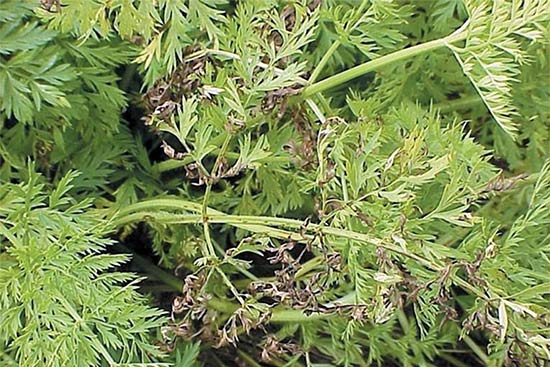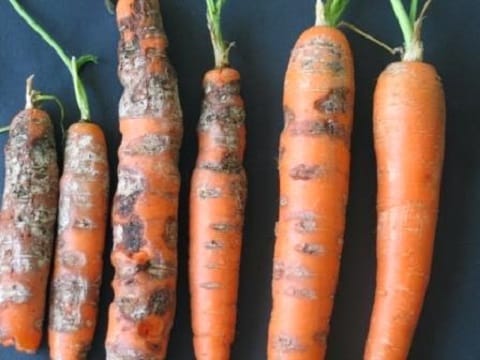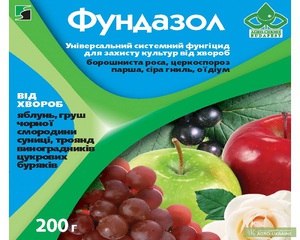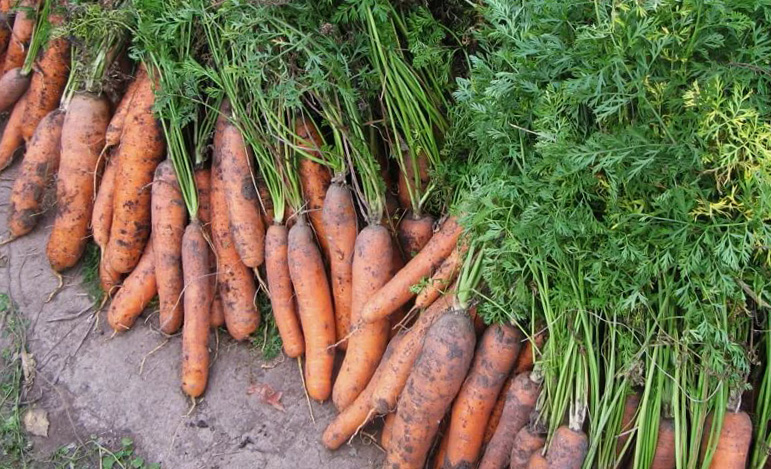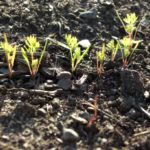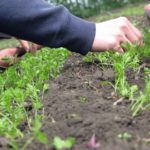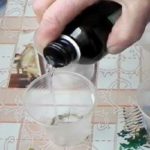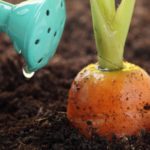People often grow vegetables (cucumbers, tomatoes, carrots, etc.) in their gardens not only for sale, but also for pleasure. However, gardening ceases to be a pleasant hobby if, for example, carrot leaves turn yellow. Let's consider why such a nuisance happens and how to solve the problem with a minimum of financial and physical costs.
Causes of yellow carrot foliage
The main reasons for yellowing of tops and root crops:
- in the fall, at the very end of the growing season, the carrot tops turn yellow and dry out;
- this can happen due to excessively hot weather;
- insufficient or excessive watering;
- if there is a lack of mineral fertilizers, in this case add phosphorus, potassium, and nitrogen to the soil;
- due to excess fertilizer;
- if chosen incorrectly carrot varieties, for example, are not suitable for planting in this area;
- carrot leaves turn yellow if there was frost at night;
- with improper care of plants, if weeds are not pulled out on time;
- carrots can get fungal diseases.
Diseases
Let's consider the most common ailments of garden vegetable crops and methods of treatment and prevention of plants.
Leaf spot (cercospora blight)
Round yellow and brown spots appear on the tops. On the petioles of the leaves, the spots are somewhat oblong and depressed. Next, the carrot leaves turn black and then rot completely. The reason for this is cercospora blight. With leaf spotting, the roots remain small, curl, and become ugly.
The disease may not occur if you loosen the soil between the rows in time and spray the carrots with decoctions of horsetail or celandine. Most fungal diseases do not occur if the soil is limed.
To prevent cercospora blight, carrot seeds are heated in hot water at a temperature of +60 °C. Young tops are sprayed with Bordeaux mixture (1%).
White spot (septoria)
Diseased foliage curls and dries. Septoria blight affects carrots in cloudy, cold weather. This occurs most often in autumn and spring. The disease can occur due to an excess of nitrogen and manure.
Fomoz (dry rot)
The disease appears in root crops in the fall. Pathogen — a fungus that overwinters in seeds, in the remains of tops, and in root crops.First, the top of the root crop is affected, then the entire vegetable becomes diseased. Small depressions are visible on it, brown with black specks - these are spores. The disease begins to become active after carrots are placed in storage. It is very difficult to cure the disease; prevention is easier.
Remove tops from the ground. Before sowing seeds, add potassium and phosphorus to the soil. Place the seeds in a solution of potassium permanganate, then germination will be better. After digging up root crops, cut off their tops. Do not store carrots that have brownish spots.
Bacteriosis
A yellowish border and spots are visible on the tops. Further, the spots become darker, but they still have a yellowish border. Then the disease spreads to petioles and roots. Brownish stripes are visible on the petioles, and the entire root crop is covered with ulcers and spots. There is a strong smell of rot.
To prevent the plant from getting sick, the seeds are placed for 10 minutes before planting. into hot water. When the sprouts appear, on the 20th day they are treated with a fungicide.
Alternaria (black rot)
The disease can be transmitted from contaminated soil and seeds. The foliage darkens, curls and dries out. Then Alternaria spreads to cuttings, and then to root crops. They become bitter and have blackish spots on them. Before the foliage is completely dry, spray the plantings with fungicides.
Powdery mildew
Foliage that is infected with powdery mildew has a whitish coating. Carrot tops become fragile. The disease occurs due to lack of fertilizing and lack of moisture in the heat. Plants are treated with fungicides against powdery mildew.
Before sowing, seeds are disinfected and heated. The soil and foliage are treated with fungicides. Fertilizers are added to the soil.
Other reasons
Carrots can be attacked by harmful insects.
Carrot flies
Carrot fly larvae overwinter in the ground in the fall and begin to emerge in the spring. The fly lays eggs in the ground, and its larvae begin to gnaw on the carrots, which makes the vegetable bitter. The foliage changes color from greenish to red.
To prevent pests from appearing, pull out weeds and thin out seedlings, and treat with fungicides in spring and summer. Sprinkling the beds with tobacco mixture, slaked lime and ash helps a lot.
Carrot psyllids
These are small insects similar to flies, but with hopping legs. Very often they appear in areas next to which pine and spruce trees grow. Insects lay eggs in carrot foliage. The larvae hatch from them and begin to drink the juices from the tops. As a result, the leaves will turn yellow and dry out.
To repel psyllids, spray the plants with tobacco infusion, soap solution, plant alternate beds of onions and carrots, place mulch of fresh sawdust on the ground, plant mustard near the carrots.
Root nematode
Root-knot nematodes are small, whitish round worms. Worms grow quickly in moist soil and lay eggs in the root system. In case of pest infestation, pour the solution onto the ground, adding 1 tablet of Decaris to 1 liter of water.
Infection with mole crickets, winter cutworms, slugs and wireworms is also possible.
Fungicides that are used
The most widely used include Fundazol, Prosaro and Falcon.
The first time is treated 2 weeks after the appearance of the first shoots, the second time - if the carrots are sick.
Advantages of systemic fungicides:
- fungicides are absorbed by carrots quite quickly and act for a very long time;
- their impact does not depend on the weather;
- they are easy and convenient to use.
When using, you should follow safety precautions and the following rules:
- treat immediately as soon as the disease is detected;
- before spraying, pull out the weeds with flowers so as not to destroy the bees;
- do not apply fungicides in cloudy or windy weather;
- Do not store the fungicide solution, but use it on the day of preparation;
- when spraying, wear a suit, mask, gloves;
- make the solution in strict accordance with the instructions.
Preventive actions
You should plant carrots one year, and the next year plant peas, beans, soybeans, beans, beets, and tomatoes.
The soil should be light and have good drainage. If the soil has acidic characteristics, add dolomite flour.
When digging the soil, add phosphorus and potassium. You can pour a weak pink solution of potassium permanganate or Fundazol on the sprouts. Plant onions and garlic near carrots - these plants repel harmful insects.
Before sowing, immerse the seeds in hot water at a temperature of up to +60 ° C for 10 minutes. Don't forget to foliar feed the plants by diluting 0.4 mg of borax in a ten-liter bucket of water.
Now you understand why the carrots in the garden turn yellow and what to do. The main thing is to follow the correct agricultural techniques, prepare the seeds, that is, put them in hot water and a solution of potassium permanganate, feed the plants on time, pull out the weeds, and water them correctly.

